
We kindly inform you that, as long as the subject affiliation of our 300.000+ articles is in progress, you might get unsufficient or no results on your third level or second level search. In this case, please broaden your search criteria.

Originaltitel: Einiges über die Arbeit der Temesvarer Komponisten und über ihre Zusammenarbeit mit dem Haus für Volkskunstschöpfung und dem Rundfunk. Verfasser: Johann Szekler. ("Neuer Weg", Bukarest", 29. Juli 1955)
More...
extracts from: "Neues Deutschland", East-Berlin, July 26, 1955 "Neues Deutschland", East-Berlin, June 9, 1955 "Der Sonntag", East-Berlin, March 20, 1955 "Der Sonntag", East-Berlin, July 3, 1955
More...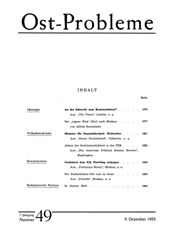

text 1: Utschiteljskaja Gaseta, Moscow, Jun 12, 1954. «Warum Waljas Mutter verärgert wurde» text 2: Trud, Moscow, Apr 25, 1954. «Die Falter» by J. Kornilov text 3: Turkmenskaja Iskra, Aschchabad, Aug 15, 1954. «Die Anhänger der 'Grünen Schlange'» text 4: Komsomolskaja Prawda, Moscow, Jan 23, 1955 «Hieran darf man nicht vorbeigehen - In Mitschurinsk wird nicht gegen den Hoolignaismus gekämpft»
More...
text 1: Sowjetskaja Kuljtura, Moscow, Jan 18, 1954 «'Stil' i ego poklonniki / Der 'Stil' und seine Verehrer» by G. Gogeberidse text 2: Komsomolskaja Prawda, Moscow, Jan 11, 1955. «Vospitanje vkusa / Geschmacksbildung» text 3: Komsomolskaja Prawda, Moscow, Sep 26, 1954. «O podlinnoj i mnimoj krasote tanca / Die wahre und die verfälschte Schönheit des Tanzes» text 4: Komsomolskaja Prawda, Moscow, Oct 31, 1954. «Otchožij promysel / Wandergewerbe»
More...
text 1: Magyar Nemzet, Budapest, Nov 21, 1954 «Rendőri ellenőrző körúton Budapesten / Polizeikontrolle auf der Ringstraße in Budapest» by Pál Magyar text 2: Magyar Nemzet, Budapest, Nov 26, 1954. «Közveszélyes munkakerülöket itéltek el / Gemeingefährliche Arbeitsscheue verurteilt» text 3: Literární Noviny, Praguem Dec 4,1954. «Falešná rodičovská láska / Falsche Elternliebe» by Vašek Kána
More...

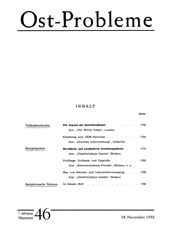

source: "Westnik Instituta po Isutscheniju Istorii i Kultury SSSR", Munich, Nr. 3, 1954 (orig. title: Die Reaktion des sowjetischen Menschen auf Nachrichten).
More...
source: "The Russian Review", Hannover, N. H., April 1954
More...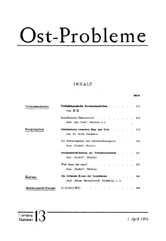

about the second volume of Ilja Ehrenbrugs novel "Thaw" (Moscow, April 1956) and its political implications
More...
text 1: "Literaturnaja Gaseta", Moscow 1956-05-08 ("Zizn' i literatura") text 2: "Partijnaja shisnj" Moscow, Nr.9, 1956 ("O principial'nosti v naučnoj rabote")
More...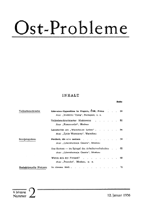
source 1: LITERATURNAJA GASETA, Oct 25, 1955. «In der Erziehung gibt es keine Bagatellen» by W. Nemzov source 2: KOMSOMOLSKAJA PRAWDA, Moscow, Nov 19, 1955. «An die Zukunft denken» source 3: PRAWDA, Moscow, Dec 11,1955. «Ein wichtiger Sektor der ideologischen Arbeit»
More...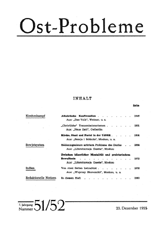
originally published: text 1 in NEUER WEG, East-Berlin, Nr. 15, 1955 ("Zur Jugendweihe 1955") by Eva Bernwald text 2 in DAS VOLK, Weimar, Nov. 11, 1955 ("Gewissensfreiheit, Konfirmation und Jugendweihe") text 3 in NEUE ZEIT, East-Berlin, Oct. 16, 1955 ("Jugendweihe")
More...
originally published in ЛИТЕРАТУРНАЯ ГАЗЕТА, Moscow, Oct. 18, 1955 ("Die Kraft des NJeuen - Bemerkungen über die Arbeiterklasse auf dem Lande") by Anatlij Slobin
More...
DEUTSCHE LEHRERZEITUNG, East-Berlin, Jan 9, 1955. «Themenplan der Jugendstunde (Für die Hand des Leiters der Jugendstunde)»
More...
"Medizinskij Rabotnik", Moskau, 8. März 1955 "Medizinskij Rabotnik", Moskau 12. Apri11955
More...